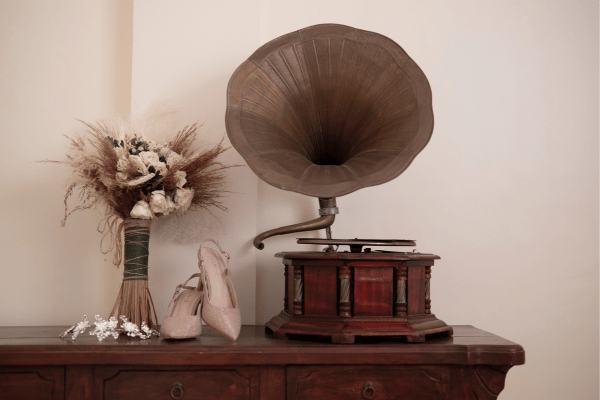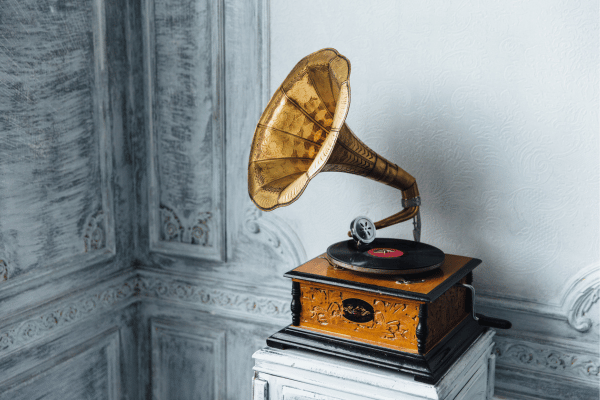An early sound recording and playback device ‘ Gramophone‘ – By Malsha – eLanka

A gramophone, also known as a phonograph, is an early sound recording and playback device. It was the primary means of playing recorded music from the late 19th century until the mid-20th century. The gramophone uses a rotating disc, typically made of shellac or vinyl, with sound information recorded as physical indentations or grooves on the surface.
When playing a record on a gramophone, a needle or stylus is placed in the grooves of the disc. As the disc spins, the stylus follows the grooves, causing vibrations that are converted into sound by a diaphragm and amplifying horn. The resulting sound is projected through the horn and can be heard by listeners.
Gramophones were originally powered by hand-cranking, where a handle would be turned to rotate the disc. Later models were developed with electric motors for convenience. The introduction of gramophones revolutionized the music industry, allowing people to listen to music in their homes and sparking the popularity of recorded music.
While gramophones have largely been replaced by modern audio technologies such as vinyl record players and digital media players, they hold historical significance as an important milestone in the development of sound recording and playback. Today, gramophones are often collectors’ items or valued for their nostalgic appeal.
The history of the gramophone dates back to the late 19th century and involves several inventors and technological advancements. Here’s a brief overview:
- Invention of the Phonograph: The precursor to the gramophone, the phonograph, was invented by Thomas Edison in 1877. Edison’s phonograph used a rotating cylinder with grooves, and a stylus would vibrate as it traveled along the grooves, reproducing sound when played back.
- Berliner’s Disc Record: Emile Berliner, a German-born inventor, introduced the disc record in the late 1880s as an improvement over the cylindrical format. Berliner’s disc had sound information recorded as lateral grooves on a flat disc, which made mass production and replication easier.
- Gramophone Company: In 1897, Emile Berliner and his associates formed the Gramophone Company in London. They developed the Gramophone, a device that played Berliner’s disc records. The Gramophone quickly gained popularity, and the term “gramophone” became a generic name for disc-playing devices.
- Victor Talking Machine Company: In the United States, Eldridge Johnson founded the Victor Talking Machine Company in 1901. The company manufactured phonographs that used disc records. Victor Talking Machine Company went on to become a prominent player in the gramophone industry, producing popular models like the Victrola.
- Technological Advancements: Over the years, various technological advancements were made to improve gramophones. These included the introduction of electric motors for automated playback, the development of more durable and flexible record materials like shellac and vinyl, and advancements in sound reproduction quality.
- Decline and Legacy: By the mid-20th century, gramophones started to be replaced by newer audio technologies like magnetic tape recorders and later, vinyl record players. The advent of digital media further accelerated their decline. However, gramophones remain highly regarded for their historical significance and nostalgic appeal. Many enthusiasts and collectors still appreciate and use gramophones to enjoy vintage recordings.
The invention and evolution of the gramophone played a crucial role in the development of the modern music industry, revolutionizing the way music was recorded, distributed, and enjoyed.
 Horn Gramophone
Horn Gramophone
Gramophones were capable of playing various types of music recorded on disc records. The types of music played on gramophones depended on the available recordings and the preferences of the listeners during different eras. Here are some common genres of music that were played on gramophones:
- Classical Music: Classical compositions by renowned composers such as Beethoven, Mozart, Bach, and Tchaikovsky were popular choices for gramophone recordings. Orchestral pieces, symphonies, operas, and solo performances by famous classical musicians could be found on gramophone records.
- Jazz: The gramophone era coincided with the emergence and popularity of jazz music in the early 20th century. Recordings of influential jazz artists like Louis Armstrong, Duke Ellington, and Bessie Smith were available and enjoyed by listeners on gramophones.
- Popular Music: Gramophones played a significant role in popularizing popular music genres of the time, such as ragtime, vaudeville, and early forms of popular songs. Vocalists like Bing Crosby, Frank Sinatra, and Ella Fitzgerald gained popularity through their gramophone recordings.
- Folk Music: Folk music from different regions and cultures was also recorded and played on gramophones. Traditional folk songs, ballads, and recordings of folk musicians became accessible to a wider audience through gramophone technology.
- World Music: Gramophone recordings brought music from around the world to listeners. Traditional music from various countries, including African, Latin American, Indian, and Middle Eastern music, was recorded and played on gramophones.
It’s important to note that the availability and popularity of specific genres varied over time and across different regions. The repertoire of music played on gramophones expanded as recording technology advanced and the music industry evolved.
There were various types of gramophones produced during the heyday of their popularity. These gramophone models differed in terms of design, size, features, and functionality. Here are some notable types of gramophones:
- Horn Gramophones: These were the earliest types of gramophones and had a distinct horn-shaped speaker. The sound produced by the needle traveling along the record’s grooves was amplified and projected through the horn, creating a unique vintage aesthetic.
- Tabletop Gramophones: These gramophones were designed to be placed on a table or a stand. They usually featured a cabinet-like structure with a turntable on top and a built-in speaker or a provision to connect external speakers. Tabletop gramophones were relatively compact and could be easily moved around.
- Console Gramophones: Console gramophones were larger, freestanding models that resembled a piece of furniture. They often had elaborate wooden cabinets with ornate designs. Console gramophones typically had built-in speakers and provided storage for records.
- Portable Gramophones: Portable gramophones were designed for easy transportation. They were compact and featured a folding or detachable lid that protected the turntable and the internal components. Some portable gramophones had a built-in speaker, while others required external amplification through a horn or other means.
- Electric Gramophones: As technology advanced, electric gramophones emerged. These models incorporated electric motors for automatic record playing, eliminating the need for hand-cranking. Electric gramophones often featured improved sound quality and convenience compared to their manual counterparts.
- Children’s Gramophones: These were smaller gramophones designed specifically for children. They often had colorful and playful designs and were equipped with smaller turntables and simplified mechanisms. Children’s gramophones typically played smaller records specifically made for them.
It’s important to note that gramophone designs varied across manufacturers and time periods. Each type of gramophone contributed to the evolution of recorded music playback and carried its own charm and aesthetic appeal. Today, vintage gramophones of various types are sought after by collectors and enthusiasts for their historical significance and nostalgic value.

Portable Gramophone
The gramophone era in Sri Lanka
The gramophone era in Sri Lanka, then known as Ceylon, spanned from the early 20th century to the mid-20th century. During this period, gramophones played a significant role in introducing and popularizing various genres of music in the country. Here are some notable aspects of Sri Lankan gramophone music during that time:
- Traditional Sri Lankan Music: Gramophones allowed for the recording and distribution of traditional Sri Lankan music genres, including classical Sinhala music, folk music, and religious music. Prominent artists and groups recorded traditional songs and compositions, preserving and popularizing these musical traditions.
- Baila Music: Baila is a popular genre of music in Sri Lanka that combines influences from Portuguese, African, and local music traditions. Baila songs, characterized by lively rhythms and humorous lyrics, became a significant part of the gramophone music repertoire in Sri Lanka. Baila music on gramophone records was often sung in a mix of Sinhala, Tamil, and Portuguese.
- Film Music: The gramophone era in Sri Lanka coincided with the growth of the country’s film industry. Film music, composed for Sinhala and Tamil movies, became popular and was released on gramophone records. These records allowed people to enjoy the songs from their favorite films in their homes.
- Sinhala Popular Music: Sinhala popular music, influenced by Western styles such as pop, jazz, and Latin music, gained popularity during the gramophone era. Singers and bands recorded Sinhala songs in various styles, catering to a wide range of tastes.
- Religious and Devotional Music: Sri Lanka has a rich religious and devotional music tradition. Gramophone recordings of Buddhist and Hindu religious chants, hymns, and devotional songs became accessible to a broader audience through this technology.
- Cultural Preservation: Gramophone recordings played a vital role in preserving Sri Lanka’s musical heritage. By capturing and archiving traditional music forms, the gramophone era contributed to the preservation of Sri Lankan cultural expressions for future generations.
During this period, gramophones provided Sri Lankans with the opportunity to listen to and appreciate a wide range of music genres, fostering cultural diversity and musical appreciation in the country.
During the gramophone era in Sri Lanka, a variety of songs were recorded and released on gramophone records. These songs encompassed various genres, including traditional music, baila, film music, and popular music. Here are some notable Sri Lankan gramophone songs from that period:
- “Goyam Kapala” by Sunil Shantha: This is a classic Sinhala song composed and sung by renowned musician Sunil Shantha. It is a folk-inspired composition that gained popularity during the gramophone era.
- “Danno Budunge” by W.D. Amaradeva: This iconic Sinhala song, composed by maestro W.D. Amaradeva, was recorded and released on gramophone records. It became a cultural phenomenon and remains one of the most beloved Sri Lankan songs to this day.
- Baila Songs by M.S. Fernando: M.S. Fernando was a prominent Sri Lankan singer known for his baila music. His recordings of lively and entertaining baila songs, such as “Kalpana Lowa Mal Wane” and “Mama Bohoma Baya Una,” were widely popular during the gramophone era.
- Film Songs: The gramophone era in Sri Lanka saw the release of numerous film songs on records. Songs from classic Sinhala and Tamil movies, sung by renowned playback singers like H.R. Jothipala, Victor Ratnayake, and Latha Walpola, were highly sought after by music enthusiasts.
- “Surangani” by A.M. Rajah: “Surangani” is a popular Sri Lankan Tamil song that gained immense popularity during the gramophone era. Sung by A.M. Rajah, it became a crossover hit and remains a well-known song in Sri Lanka.
- Sinhala Pop Songs: The gramophone era also witnessed the rise of Sinhala pop music. Artists such as C.T. Fernando, Desmond de Silva, and Clarence Wijewardena released catchy and melodic pop songs that became instant hits, including “Malata Bambaraku Se” and “Mango Nanda.”
These are just a few examples of the diverse range of Sri Lankan gramophone songs that were recorded and enjoyed during that era. The gramophone played a pivotal role in introducing and popularizing these songs, contributing to the rich musical heritage of Sri Lanka.







